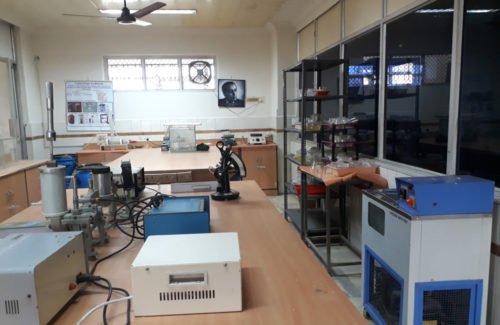Research Lab
Microwave Bench X-Band
Tubular Furnace (RT to 1400˚C)
Box Furnace(RT to 1400˚C)
Constant Temperature Water Bath
Physics Lab
Physics Lab
The purpose of Physics Laboratory is to develop scientific temper, analytical capability among the engineering students and to understand the general scientific concepts required for technology and apply the concepts in solving engineering problems. This laboratory also explains scientifically the new developments in engineering and technology and to familiarize with the concepts, theories and models behind many technological applications.
The Physics Laboratory is employed to practice the scientific experiments – asking questions, performing procedures, collecting data, analysing data, and thinking of new questions to explore the knowledge in physics and materials science. Students can perform experiments on Uniform Bending, Torsion Pendulum, Spectrometer, Potentiometer, Lasers, Optical Fibre, and general electronic circuits. The laboratory also has provision to perform experiments on Post office box, Four Probe Method, Dielectric Constant Measurement, Photoconductivity measurement, Hall Effect, and Magnetic Susceptibility.
Utilization
| 18PYB101J | Physics: Electromagnetic Theory, Quantum Mechanics, Waves and Optics Laboratory for I year B.Tech ECE, EKE, MECH, MECH(AUTOMATION) & EEE |
| 18PYB102J | Physics: Mechanics and Mechanics of Solids Laboratory for I year B.Tech.Civil |
| 18PYB103J | Physics: Semiconductor Physics Laboratory for I year B.Tech.CSE & IT |
| 18PYB161J | Fundamental of Physics Laboratory for I year B.Tech BCS |
| 18PYB104T | Engineering Physics Laboratory for Lateral Entry |
| 18PYB101J | Physics: Electromagnetic Theory, Quantum Mechanics, Waves and Optics |
| 18PYB103J | Physics: Semiconductor Physics |
Experiments Prescribed for Laboratory Courses
Numerical aperture of an optical fibre, laser source for the determination of laser parameter, Particle size determination, Four probe apparatus, Hall effect setup, Quincke’s setup, Dielectric constant measurement apparatus, Lee’s disc apparatus, Post office box apparatus, Hysteresis loss measurement apparatus, Photoconductivity measurement, IC regulated power supply, Solar cell characteristics, Newton’s Ring Experiment, Forward and Reverse bias characteristics of a diode, Spectrometer-Diffraction Grating, Maxwells Fly Wheel, Pivot Bearing Apparatus, Sliding/Rolling friction analysis.
Location
The Physics Laboratory is located at the Fourth Floor of New Admin Block.
| Faculty | Designation | Email ID | Mobile Number |
| Dr A. Nataraj | Lab In-Charge & Assistant Professor(S.G) | nataraja@srmist.edu.in | 9790080355 |
The state of the art research laboratory has all the latest equipments such as
- Dielectric constant measurement
- X – Band Microwave bench
- Four probe set up
- Ultrasonic Interferometer
- The crystal growth technique – SR method
- Computational Physics – VASP code
- Box and tubular furnace upto 1400 ºC
Background
The focus of Research Laboratory is to develop the science underlying the Synthesis of Advanced Materials and characterization for the applications in the areas of Nanotechnology, Laser & Non-Linear Optics, Optoelectronics, Magnetism, and Dielectrics. This Laboratory aims to achieve progress in these technologically-important areas through a detailed atomic-level understanding of the mass transport mechanisms, chemical reaction kinetics, electrical, optical, mechanical and thermal properties. Active Research is being carried out in the field of X-ray Crystallography, Dielectrics, Nanoscience & Technology, Crystal Growth, Ceramic Compounds, Magnetic Materials and Theoretical Modelling.
Description
The purpose of Research Laboratory is to develop scientific research in Physics and Materials Science. The active research team of the department periodically publishes papers in National/International Journals and in conferences for attaining in-depth knowledge about the latest developments of Science and Technology.
Our department is funded with Pilot Research Project (funded by Management) and DST-SERB Grants through which equipment’s have been purchased for research activities.
List of Research Supervisors and Area of Specialization
| S.No. | Name of the Staff | Area of Research | Recognized by University on (Year) |
| 1 | Dr. A. Senthil | Crystal Growth | 2013 |
| 2 | Dr. A. Nataraj | Spectroscopy and Quantum Chemical Calculations | 2015 |
| 3 | Dr. S. Ranjith | Crystallography and Biophysics | 2015 |
| 4 | Dr. V. Jayalakshmi | Structural Stability and Band structure Calculation | 2016 |
| 5 | Dr. T. Beena | Spectroscopy, Thermoelectrics, Quantum Optics | 2019 |
| 6 | Dr. M. Saravanan | Crystal Growth | 2019 |
| 7 | Dr. N. Karunagaran | Crystal Growth | 2020 |
| 8 | Dr.Sanju Rani | Nanomaterials, Photo catalysis, Gas Sensors | 2021 |
| 9 | Dr. M. Dhanasekar | Thinfilm solar cell | 2021 |
VASP Code
The Vienna Ab initio Simulation Package (VASP) is a computer program for atomic scale materials modelling, e.g. electronic structure calculations and quantum-mechanical molecular dynamics, from first principle.
Tubular Furnace (RT to 1400˚C)
A tube furnace is an electric heating device used to conduct syntheses and purifications of inorganic compounds and occasionally in organic synthesis. One possible design consists of a cylindrical cavity surrounded by heating coils that are embedded in a thermally insulating matrix. Temperature can be controlled via feedback from a thermocouple.
Box Furnace(RT to 1400˚C)
A box furnace is an electric heating device used to conduct syntheses and purifications of inorganic compounds and occasionally in organic synthesis. Here the high temperatures of around 1400 ˚C is reached due to the SiC heating rods present in the design. Temperature can be controlled via feedback from a thermocouple.
Constant Temperature Water Bath
A constant temperature water bath is a laboratory equipment made from a container filled with heated/constant temperature water. It is used to incubate samples in water at a constant temperature over a long period of time. There is a digital interface to allow users to set a desired temperature.
Microwave Bench X-Band
Microwave Test Bench are used for study of Microwave Characteristics like Guide Wavelength, Free Space Wavelength, Cut off Wavelength, Frequency, Klystron Characteristics, Gunn diode Characteristics, Klystron Mode Study, VSWR, Impedance, Reflection Characteristics, magic Tee, Directional Couplers, Dielectric Value, Power Measurement, Circuit parameters, Isolation Value, Insertion Loss, Attenuation, Gain, Directivity and radiation pattern of Antennas etc.,
Location
The Research laboratory is located in Third Floor of Block V (University Main Block) and Fourth Floor of New Admin Block.









